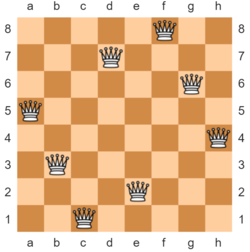Sequential N Queens Assignment
Motivation
Not everything in the world should be divided and conquered. Backtracking is a powerful technique which can be readily parallelized. We will gain experience with backtracking by solving the N-Queens problem sequentially and in parallel.
N-Queens in particular can be used to explain the call stack as the chessboard *IS* the call stack.
Background
The n-queens problem is a fundamental coding puzzle which asks: how can N queens be placed on an NxN chessboard so that they cannot attack each other? In chess, a queen can attack horizontally, vertically, and diagonally across the board. Thus, to solve the n-queens problem, we must effectively figure out how to place the queens in such a way that no two of them occupy the same row, column, or diagonal. We will be building a method that finds the total number of solutions for n-queens for any given n.
Code To Implement
Sequential Warm Up
public static int countSolutions(int boardSize) {
MutableInt count = new MutableInt();
int[] board = new int[boardSize];
Arrays.fill(board, EMPTY);
search(count, board, 0);
return count.intValue();
}
| class: | SequentialNQueens.java | |
| methods: | search | |
| package: | nqueens.warmup | |
| source folder: | student/src/main/java |
method: private static void search(MutableInt count, int[] board, int row) ![]() (sequential implementation only)
(sequential implementation only)
